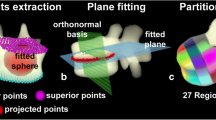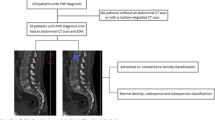Abstract
Osteoporosis (OP) is a bone-related ailment that aggravates owing to the decline in bone mineral density (BMD) or during deviations in the structure or quality of bone that may surge to fractures. The low BMD can be recognized from computed tomography (CT), X-ray, or Dual Energy X-ray absorptiometry (DXA/DEXA). Texture analysis is the most significant and distinguishing image feature. An enhanced discrimination power texture feature extraction system is developed for volumetric images by combining two complementary types of information: local binary patterns (LBP) and normalized grey-level co-occurrence matrix-based (nGLCM) techniques to extract features and U-Net for classification. The developed algorithm was validated on a Kaggle dataset comprising X-ray images acquired from patients suffering from osteoporosis. The modified U-Net (ModU-Net) semantic segmentation classifier is used for segmenting the low bone mass sections in the processed image. The developed LGMU-Net algorithm outperforms conventional feature extraction approaches and neural networks with a Dice Score of 88.82%, Tanimoto Co-efficient index of 71.74%, MSE of 0.0321, and PSNR of 65.74 dB. This method assists physicians in making early diagnoses and also protects patients from bone fraility and eventual fractures by ensuring that they follow the medications/surgery options prescribed by the doctors.










Similar content being viewed by others
Data availability
The datasets generated during and/or analysed during the current study are available from the corresponding author on reasonable request.
References
Lorentzon M, Johansson H, Harvey NC, Liu E, Vandenput L, McCloskey EV, Kanis JA (2022) Osteoporosis and fractures in women: the burden of disease. Climacteric 25(1):4–10
Vilaca T, Richard E, Marian S (2022) Osteoporosis in men. The Lancet Diabetes Endocrinol 10(4):273–283
Gregson CL, Armstrong DJ, Bowden J, Cooper C, Edwards J, Gittoes NL, Harvey N et al (2022) UK clinical guideline for the prevention and treatment of osteoporosis. Arch Osteoporos 17(1):1–46
Conradie M, de Villiers T (2022) Premenopausal osteoporosis. Climacteric 25(1):73–80
Bimal G, Sahhar J, Savanur M, Ngian G-S (2022) Screening rates and prevalence of osteoporosis in a real-world, Australian systemic sclerosis cohort. Int J Rheum Dis 25(2):175–181
Godos J, Giampieri F, Chisari E, Micek A, Paladino N, Forbes-Hernández TY, Quiles JL et al (2022) Alcohol consumption, bone mineral density, and risk of osteoporotic fractures: a dose-response meta-analysis. Int J Environ Res Publ Health 19(3):1515
Zhu K, Hunter M, Stuckey BG, Walsh JP (2022) Establishing a total hip t-score threshold to measure contralateral hip bone mineral density: avoiding missed diagnosis of osteoporosis. J Clin Densitom 25(4):577–586
Anabtawi A, Holyoak M, He J, Cristiano E, Polineni D, Graves L (2022) "Trabecular bone score in people with cystic fibrosis." Osteoporos Int. 33(5):1137–1145
Johansson L, Johansson H, Axelsson KF, Litsne H, Harvey NC, Liu E, Leslie WD et al (2022) Improved fracture risk prediction by adding VFA-identified vertebral fracture data to BMD by DXA and clinical risk factors used in FRAX. Osteoporos Int 33(8):1–14
Martel D, Anmol M, Gregory C (2022) "Osteoporosis Imaging." Radiologic Clinics.
Fathima SMN, Tamil Selvi R, Parisa Beham M (2019) Assessment of BMD and statistical analysis for osteoporosis detection. Biomed Pharmacol J 12(4):1907–1914
Hussain D, Naqvi RA, Loh WK, Lee J (2021) Deep learning in DXA image segmentation. Comput Mater Contin 66(3):2587–2598
Pai KM (2022) Region detection and segmentation of brain hemorrhage using algorithmic approach of image processing. In J Phys Conf Ser 2161(1):012070
Magnuska ZA, Theek B, Darguzyte M, Palmowski M, Stickeler E, Schulz V, Kießling F (2022) Influence of the computer-aided decision support system design on ultrasound-based breast cancer classification. Cancers 14(2):277
Jalali SMJ, Ahmadian M, Ahmadian S, Hedjam R, Khosravi A, Nahavandi S (2022) X-ray image based COVID-19 detection using evolutionary deep learning approach. Expert Syst Appl 201:116942
Tang X, Bai Y, Zhang Z, Lu J (2020) A validated miRNA signature for the diagnosis of osteoporosis related fractures using SVM algorithm classification. Exp Ther Med 20(3):2209–2217
Rao DT, Ramesh KS, Ghali VS, Rao MV (2022) The osteoporosis disease diagnosis and classification using U-Net deep learning process. J Mob Multimed 18(4):1131–1152
Sukegawa S, Fujimura A, Taguchi A, Yamamoto N, Kitamura A, Goto R, Furuki Y (2022) Identification of osteoporosis using ensemble deep learning model with panoramic radiographs and clinical covariates. Sci Rep 12(1):1–10
Wang X, Xu Z, Tong Y, Xia L, Jie B, Ding P, He Y (2022) Detection and classification of mandibular fracture on CT scan using deep convolutional neural network. Clin Oral Investig 26(6):1–9
Uemura K, Otake Y, Takao M, Makino H, Soufi M, Iwasa M, Sato Y (2022) Development of an open-source measurement system to assess the areal bone mineral density of the proximal femur from clinical CT images. Arch Osteoporos 17(1):1–11
Wang F, Zheng K, Lu L, Xiao J, Wu M, Kuo CF, Miao S (2022) Lumbar bone mineral density estimation from chest x-ray images: anatomy-aware attentive multi-ROI modeling. arXiv preprint arXiv:2201.01838
Rühling S, Navarro F, Sekuboyina A, El Husseini M, Baum T, Menze B, Kirschke JS (2022) Automated detection of the contrast phase in MDCT by an artificial neural network improves the accuracy of opportunistic bone mineral density measurements. Eur Radiol 32(3):1465–1474
Monchka BA, Schousboe JT, Davidson MJ, Kimelman D, Hans D, Raina P, Leslie WD (2022) Development of a manufacturer-independent convolutional neural network for the automated identification of vertebral compression fractures in vertebral fracture assessment images using active learning. Bone 161:116427
Xue Z, Huo J, Sun X, Sun X, Liu C (2022) Using radiomic features of lumbar spine CT images to differentiate osteoporosis from normal bone density. BMC Musculoskelet Disord 23(1):1–9
Zhang Z, Wang M (2022) Multi-feature fusion partitioned local binary pattern method for finger vein recognition. Signal Image Video Process 16:1–9
Qiao S, Qinghan Yu, Zhao Z, Song L, Tao H, Zhang T, Zhao C (2022) Edge extraction method for medical images based on improved local binary pattern combined with edge-aware filtering. Biomed Signal Process Control 74:103490
Althubiti SA, Sanchita P, Rajanikanta M, Sachi NM, Fayadh A, Kemal P (2022) "Ensemble learning framework with GLCM texture extraction for early detection of lung cancer on ct images." Comput Math Method Med
Zhang YD, Wei W, Xin Z, Shui-Hua W (2022) "Secondary pulmonary tuberculosis recognition by 4-direction varying-distance GLCM and fuzzy SVM." Mob Netw Appl 1–14
Alqudah AM, Alqudah A (2022) Improving machine learning recognition of colorectal cancer using 3D GLCM applied to different color spaces. Multimed Tools Appl 81(8):10839–10860
Hashemi M, Akhbari M, Jutten C (2022) Delve into multiple sclerosis (MS) lesion exploration: a modified attention U-Net for MS lesion segmentation in brain MRI. Comput Biol Med 145:105402
Ilhan A, Sekeroglu B, Abiyev R (2022) Brain tumor segmentation in MRI images using nonparametric localization and enhancement methods with U-Net. Int J Comput Assist Radiol Surg 17(3):589–600
Hidjah K, Harjoko A, Wibowo ME, Shantiningsih RR (2022) Periapical radiograph texture features for osteoporosis detection using deep convolutional neural network. Int J Adv Comput Sci Appl 13(1):223–232
Deshmukh S, Khaparde A (2022) Multi-objective segmentation approach for bone age assessment using parameter tuning-based U-Net architecture. Multimed Tools Appl 81(5):1–46
Kaggle Osteoporosis Dataset: https://www.kaggle.com/datasets/stevepython/osteoporosis-knee-xray-dataset
Zhang Y-D, Pan C, Sun J, Tang C (2018) Multiple sclerosis identification by convolutional neural network with dropout and parametric ReLU. J Comput Sci 28:1–10
Varshney M, Singh P (2021) Optimizing nonlinear activation function for convolutional neural networks. SIViP 15(6):1323–1330
Li CH, Lee CK (1993) Minimum cross entropy thresholding. Pattern Recognit 26(4):617–625
Jumiawi WAH, El-Zaart A (2023) Gumbel (EVI)-based minimum cross-entropy thresholding for the segmentation of images with skewed histograms. Appl Syst Innov 6(5):87
Kittaneh OA (2023) The variance entropy multi-level thresholding method. Multimed Tools Appl 28:1–13
Jumiawi WAH, El-Zaart A (2022) A boosted minimum cross entropy thresholding for medical images segmentation based on heterogeneous mean filters approaches. J Imaging 8(2):43
Otsu N (1979) A threshold selection method from gray-level histograms. IEEE Trans Syst Man Cybern 9(1):62–66
Abubakar UB, Moussa MB, Steve A (2022) "Comparison of transfer learning model accuracy for osteoporosis classification on knee radiograph." In 2022 2nd international conference on computing and machine intelligence (ICMI), pp. 1–5. IEEE
Kumar A, Rakesh CJ, Malay KD, Radim B, Vojtech M (2022) "Osteo-Net: a robust deep learning-based diagnosis of osteoporosis using x-ray images." In 2022 45th international conference on telecommunications and signal processing (TSP), pp. 91–95. IEEE
Acknowledgements
The authors thank Dr.R.Sayee Venkatesh, M.D.(General Medicine), D.M.(Cardio), Chennai, Tamilnadu, India, for supporting the research. Also, the authors thank the International Research Centre of Kalasalingam Academy of Research and Education, Tamil Nadu, India, for permitting them to use the computational facilities available in the Biomedical Research and Diagnostic Techniques Development Centre. This research was supported by the Department of Science and Technology, New Delhi, under the Biomedical Device and Technology Development Scheme (BDTD) of the Technology Development Programme (TDP). (Ref. No. DST / TDP / BDTD / 28 / 2021 (G)).
Funding
The author(s) disclosed receipt of the following financial support for the research, authorship, and/or publication of this article: This work was supported by the Department of Science and Technology [DST/TDP/BDTD/28/2021(G)].
Author information
Authors and Affiliations
Contributions
Conceptualization: Gautam Amiya; Data curation: Kottaimalai Ramaraj, Muneeswaran Vasudevan; Formal Analysis: Vishnuvarthanan Govindaraj; Investigation: Gautam Amiya; Methodology: Gautam Amiya; Project administration: Pallikonda Rajasekaran Murugan; Supervision: Pallikonda Rajasekaran Murugan, Thirumurugan M; Validation: Thirumurugan M, Sheik Abdullah S; Visualization: Arunprasath Thiyagarajan; Writing – original draft: Gautam Amiya; Writing – review and editing: Kottaimalai Ramaraj, Vishnuvarthanan Govindaraj.
Corresponding authors
Ethics declarations
Conflict of interest
All authors have no conflicts of interest.
Informed consent
Informed consent was obtained from all individual participants included in the study.
Additional information
Publisher's Note
Springer Nature remains neutral with regard to jurisdictional claims in published maps and institutional affiliations.
Rights and permissions
Springer Nature or its licensor (e.g. a society or other partner) holds exclusive rights to this article under a publishing agreement with the author(s) or other rightsholder(s); author self-archiving of the accepted manuscript version of this article is solely governed by the terms of such publishing agreement and applicable law.
About this article
Cite this article
Amiya, G., Murugan, P.R., Ramaraj, K. et al. LMGU-NET: methodological intervention for prediction of bone health for clinical recommendations. J Supercomput 80, 15636–15663 (2024). https://doi.org/10.1007/s11227-024-06048-2
Accepted:
Published:
Issue Date:
DOI: https://doi.org/10.1007/s11227-024-06048-2




